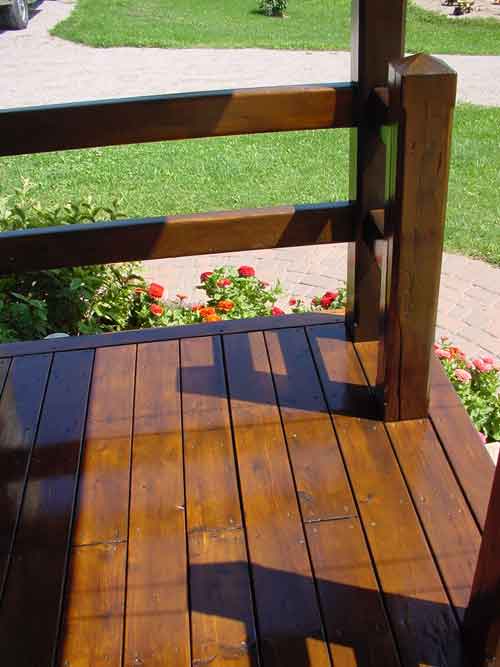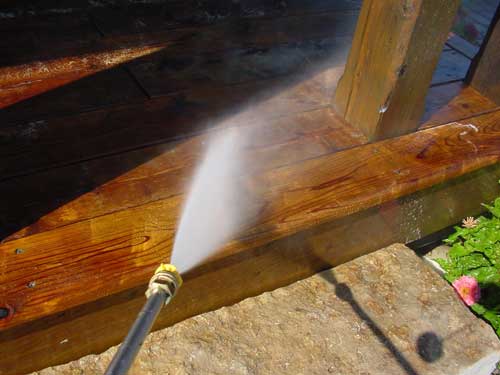 Almost everyone who puts up a new wooden deck is inevitably offered a range of information from friendly, well-meaning neighbours and relatives about when, where and how to finish it properly. But since a good part of this advice is often conflicting, the real trick involves deciding which strategy is actually true. And when it comes to decks, reality can be more than a little surprising.
Almost everyone who puts up a new wooden deck is inevitably offered a range of information from friendly, well-meaning neighbours and relatives about when, where and how to finish it properly. But since a good part of this advice is often conflicting, the real trick involves deciding which strategy is actually true. And when it comes to decks, reality can be more than a little surprising.
After several disappointing attempts to finish outdoor wood back in the 1980s, I decided to spend as much time as necessary discovering the truth behind successful deck finishing. So, after talking to lab technicians at leading wood finish manufacturers, representatives from the Canadian Wood Council and the USDA Forest Service, I put together several strategies that use all the best advice available today. And since I’ve been using these approaches for more than 15 years of finishing outdoor wood, I can say for sure that they really do work.
There are three reasons deck finishing isn’t as simple as it looks:
- The first is that many finishing products are doomed to failure from the start. Independent consumer testing has proven that many formulations fail after less than a year of duty. And of the ones that make it past their first birthday, few offer more than mediocre performance. That’s why step one is simple: choose a deck finish that has proven itself effective through independent scrutiny. More on this evolving situation later.
- The second source of trouble springs from the way people envision the outcome of their deck finishing efforts. Even with a very good product applied correctly, the need for ongoing maintenance of a wooden deck is higher than many folks expect. If you can get three years of life out of a wooden deck finish, you’re doing well. Even 18 months of respectable appearance isn’t bad considering the moisture, sunlight and abrasion that most decks are subjected to. This is why step to involves assessing yourself. Do you really have the time and ambition to maintain a wooden deck finish?
- The third and final challenge of the deck finishing game involves understanding what proper application really means. New wood is actually a rather poor candidate for finishing, and letting it sit unfinished until it turns grey (a popular, though misguided approach) does little to improve the situation.
Choose Wisely
The only reliable and extensive source of independent testing of deck finishes that I know of is Consumer Reports. They’ve conducted an ongoing deck finish survey for more than a decade, observing dozens of products from the three  main types of deck finish families: clear, transparent formulations; semi-transparent products; and opaque deck finishes. In general, the most demanding finishing strategy involves trying to keep new wood looking new and bright. That’s the challenge that clear, transparent deck finishes attempt to meet. But since clear products create little or no protective surface film, they have a more challenging time protecting wood from ultraviolet rays. That’s why durability results are lower with clear products than any other type. If you want to retain some visibility of wood grain, while also introducing colour to your deck along with greater durability, consider a tinted, semi-transparent product.
main types of deck finish families: clear, transparent formulations; semi-transparent products; and opaque deck finishes. In general, the most demanding finishing strategy involves trying to keep new wood looking new and bright. That’s the challenge that clear, transparent deck finishes attempt to meet. But since clear products create little or no protective surface film, they have a more challenging time protecting wood from ultraviolet rays. That’s why durability results are lower with clear products than any other type. If you want to retain some visibility of wood grain, while also introducing colour to your deck along with greater durability, consider a tinted, semi-transparent product.
The most durable deck finishes of all are the opaque products that look like paint. These offer the greatest UV protection and abrasion resistance. For a list of proven deck finishes that actually work, and detailed descriptions of exactly how to prepare wood for maximum finish life, download my free deck finishing report.